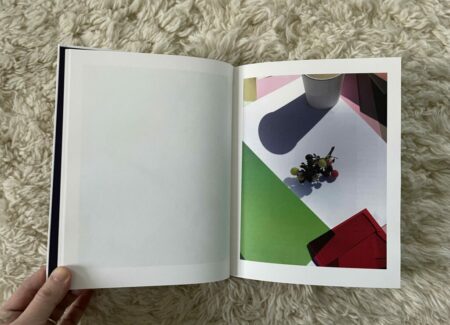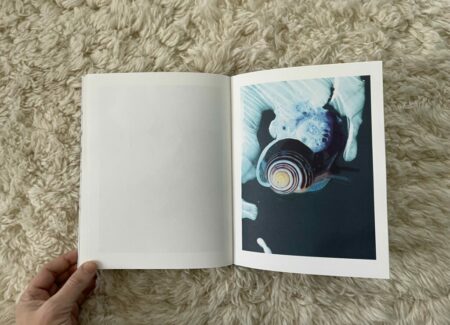JTF (just the facts): Published in 2022 by Jean Boîte Éditions (here). Hardcover, 7.8 × 10.2 inches, 160 pages, with 80 color images by Sassen. Includes an essay (in English) by Coccia. The project was sponsored by Maison Perrier-Jouët. (Cover and spread shots below.)
Comments/Context: Seeing Viviane Sassen’s photographs always seems to raise questions about the nature of aesthetic disruption. How is it that images made within a wholly recognizable genre or tradition can feel so consistently unexpected and disorienting? And what is it about Sassen’s eye for composition that makes her photographs so familiar and yet so subtly puzzling?
In the roughly fifteen years since Sassen arrived on the scene, the Dutch photographer’s pictures have comfortably traversed the intermediate zone between fine art and fashion, only to repeatedly upend our sense of how such images function. Nude or clothed, posed in the studio or staged in almost dream-like natural settings, her models have been transformed by Sassen’s twisting camera angles and vantage points, her bold use of interrupting shadow, and her introduction of bright often geometric color, via filters and gels. As seen in her 2017 photobook Roxane II (reviewed here), her results have gathered these approaches and tools into photographs the merge formal grace and sensuality with expressionistic energy and deliberate visual confusion.
In the past few years, Sassen has been busy with a string of projects and commissions, each one building out her toolkit of disruption a step or two further. She’s added splashy colored ink blots, gestural overpainting (often with repeated textural brushstrokes), and intricate elements of collage, and used rephotography to flatten out the layers and to create additional overlaps. Sassen’s newest photobook Modern Alchemy brings all these ideas together, in a sense consolidating a handful of discrete innovations into one more integrated whole.
Modern Alchemy is balanced marriage of image and text; it isn’t just a parade of photographs with an essay bolted on at the end, but a carefully orchestrated back and forth between Sassen’s images and an essay (in 12 parts) by the contemporary philosopher Emanuele Coccia. The two contributors are essentially given equal billing on the cover and the spine, and the book feels tightly integrated, like an intimate dialogue, with the words and pictures smartly informing each other.
In ultimately driving toward an elusive definition of alchemy (from the book’s title), Coccia takes a roundabout and wandering path through various adjacent and interrelated lines of thinking, including quick forays into chemistry, geology, and neuroscience, among other topics. He thinks about the interdependent connection between hands and brain, and how we manipulate, manufacture, and transform our world out of elemental materials. He then digs deeper into connections between mind and matter and the ways we comprehend reality, leading to conclusions about the pervasiveness of design, intention, and the infinite recombination of intelligence and nature. Alchemy eventually enters the conversation in the ways the relationships of mind and matter become something else, the fluidity of assemblage and human tinkering leading to seemingly endless forms of newness.
Set against this intellectual framework, Sassen’s compositions rise to meet the challenge of illustrating (or informing, inspiring, influencing, and responding to) Coccia’s ideas. In general, Sassen seems to be interrogating a fantastical hybrid world, where humans and nature intersect and reconfigure themselves in unexpected combinations. Female nudes and disembodied body parts are grafted onto floral blossoms, reaching branches, and clusters of wildflowers and weeds, creating new kinds of life forms. She does the same with a range of insects, lizards, and animals, mixing snails, ladybugs, moths, spiders, and a praying mantis or two with fruits, flowers, and vegetables, once again deploying precise modes of overpainting, shadow manipulation, watery ink blot spotting, and color tinting to further amplify her surreal linkages. Each imaginative work ends up bring a study in intervention and recontextualization, the gently disconcerting Frankenstein creatures and sculptural assemblies constantly offering one vision and then upending it with a handful of contradictions and reassertions.
As presented in Modern Alchemy, where the reproductions are moderately sized, there is an intimacy about these works that makes them feel like studies or sketches. This is especially true when the exacting precision of the collaging meets the more chance elements of the ink or the painted brushstrokes, Sassen’s ideas being reworked in ways that aren’t entirely in her control. The strongest of the works in the photobook feel unsettled and interwoven, the forms and textures spliced together and just momentarily in a kind of equilibrium. Many images rely on an unexpected charge of strangeness, where a lizard joins the petals of a flower, colored ink blots echo floral arrangements like neon lights, and body parts are layered into contorted tangles with too many arms, legs, or breasts. Scale and proportion also seem to be entirely malleable, further confusing our sense of what we’re seeing; suddenly full human figures are attached to spindly stems, moth wings mimic brushstrokes, and bent legs are the same size as petal edges. It’s like we’ve tumbled into an alternate universe, where the possibilities for reconfiguration aren’t as rigidly bounded as in our own.
Modern Alchemy offers a kind of visual freedom we don’t see enough of, where risks are allowed to percolate until they coalesce into something new. As an integrated artistic statement, Sassen and Coccia’s collaboration is filled with openness, the resonances between image and text creating a fuller experience of grasping for something we can’t quite name. It’s a book filled with testing, trying, and hypothesizing, leading to sophisticated works and ideas that seem to liberally metastasize and reconfigure themselves on the fly.
Collector’s POV: Viviane Sassen is represented by Stevenson in Cape Town (here). Sassen’s works have not yet reached the secondary markets with any regularity, so gallery retail remains the best option for those collectors interested in following up.

































